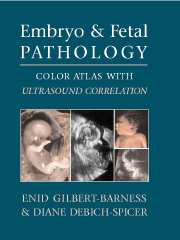Book contents
- Frontmatter
- Contents
- Foreword by John M. Opitz
- Preface
- Acknowledgments
- 1 The Human Embryo and Embryonic Growth Disorganization
- 2 Late Fetal Death, Stillbirth, and Neonatal Death
- 3 Fetal Autopsy
- 4 Ultrasound of Embryo and Fetus: General Principles
- 5 Abnormalities of Placenta
- 6 Chromosomal Abnormalities in the Embryo and Fetus
- 7 Terminology of Errors of Morphogenesis
- 8 Malformation Syndromes
- 9 Dysplasias
- 10 Disruptions and Amnion Rupture Sequence
- 11 Intrauterine Growth Retardation
- 12 Fetal Hydrops and Cystic Hygroma
- 13 Central Nervous System Defects
- 14 Craniofacial Defects
- 15 Skeletal Abnormalities
- 16 Cardiovascular System Defects
- 17 Respiratory System
- 18 Gastrointestinal Tract and Liver
- 19 Genito-Urinary System
- 20 Congenital Tumors
- 21 Fetal and Neonatal Skin Disorders
- 22 Intrauterine Infection
- 23 Multiple Gestations and Conjoined Twins
- 24 Metabolic Diseases
- Appendices
- Index
5 - Abnormalities of Placenta
Published online by Cambridge University Press: 23 February 2010
- Frontmatter
- Contents
- Foreword by John M. Opitz
- Preface
- Acknowledgments
- 1 The Human Embryo and Embryonic Growth Disorganization
- 2 Late Fetal Death, Stillbirth, and Neonatal Death
- 3 Fetal Autopsy
- 4 Ultrasound of Embryo and Fetus: General Principles
- 5 Abnormalities of Placenta
- 6 Chromosomal Abnormalities in the Embryo and Fetus
- 7 Terminology of Errors of Morphogenesis
- 8 Malformation Syndromes
- 9 Dysplasias
- 10 Disruptions and Amnion Rupture Sequence
- 11 Intrauterine Growth Retardation
- 12 Fetal Hydrops and Cystic Hygroma
- 13 Central Nervous System Defects
- 14 Craniofacial Defects
- 15 Skeletal Abnormalities
- 16 Cardiovascular System Defects
- 17 Respiratory System
- 18 Gastrointestinal Tract and Liver
- 19 Genito-Urinary System
- 20 Congenital Tumors
- 21 Fetal and Neonatal Skin Disorders
- 22 Intrauterine Infection
- 23 Multiple Gestations and Conjoined Twins
- 24 Metabolic Diseases
- Appendices
- Index
Summary
EXAMINATION OF PLACENTA
The placenta should be examined fresh and weighed after the removal of the cord and membranes. Cord length is measured in toto. The cord's insertion site is noted. The placental membranes are examined for both completeness and color. The chorionic vasculature is studied, and notes on aberrancies should be recorded. The cord and membranes are trimmed from the placenta before its weight is determined. The parenchyma of the placenta is examined in “bread loaf” sections to identify irregularities.
A membrane roll is made, which is derived from spiral rotation of the membranes with the point of rupture at the center. This is sectioned (Figure 5.1 and Tables 5.1 to 5.3).
Sections to be microscopically examined include a cross section of the cord, the membrane roll, and three sections from the parenchyma including central and peripheral areas of the placental disc. Any grossly abnormal lesions should also be sectioned.
PLACENTA
The placental parenchyma consists of the villous tissue beneath the chorionic plate and the intervillous space.
ABNORMAL PLACENTAL WEIGHT
Fetal placental weight ratios have been established for various gestational ages (Tables 5.4 to 5.10). At 24 weeks, this ratio is equal to four and increases to seven at term. Small placentas are seen in preeclampsia, low birth weight, and accelerated villous maturation.
Large placentas are seen with villous edema, severe maternal anemia, fetal anemia, syphilis, large intervillous thrombi, maternal diabetes, subchorionic thrombosis, toxoplasmosis, congenital fetal nephrosis, idiopathic fetal hydrops, and multiple placental chorangiomas (Table 5.11).
- Type
- Chapter
- Information
- Embryo and Fetal PathologyColor Atlas with Ultrasound Correlation, pp. 150 - 179Publisher: Cambridge University PressPrint publication year: 2004



